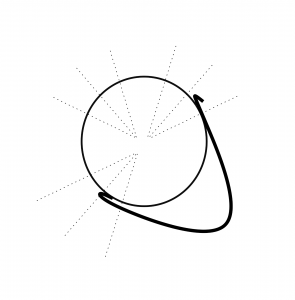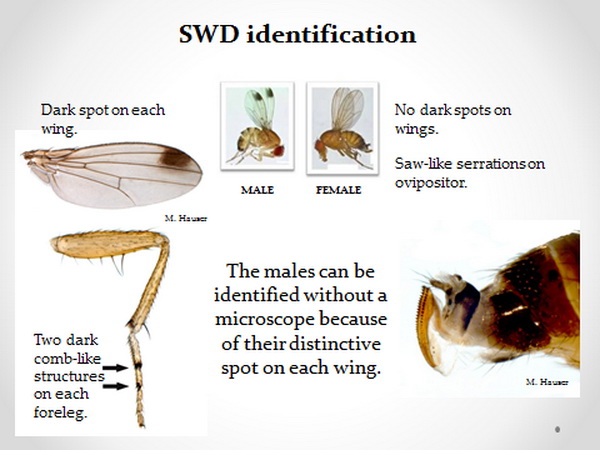As we transition from mid-summer to late-summer in New York State, spotted wing drosophila (SWD) populations are rising. The SWD is a troublesome fly that is capable of inserting eggs into firm, under-ripe berries. The eggs hatch inside of the berries and grow into larvae. Since the introduction of SWD to New York State in the past decade, the presence of larva in berries have caused sizable profit losses for berry growers.
Monitoring populations of SWD on your farm can give you the most accurate information on the status of this pest. 2 DIY tactics to monitor SWD populations are salt flotations and bait traps.
Salt Flotations
The purpose of a salt flotation is to look inside a small sample of your berries and see if they have already been infested with SWD– you will be able to see approximately how many larvae there are per fruit.
How to Do a Salt Flotation
- Collect a sample of 10 – 25 berries from your patch.
- Dissolve 1 cup of salt in 1 gallon of water.
- Pour some of the dissolved water into a quart-size, transparent plastic bag or a clear glass bowl.
- Gently squeeze and massage the berries to bruise the skin. Try to create a few small tears in the skin without pressing out too much pulp.
- Place the berries into the bag or bowl that holds the salt water.
- Wait 15 minutes.
- Place the bag or bowl against a blast background. If SWD larvae are in the fruit, you will be able to count the white larvae easily against the black background.
- Divide the number of larvae found by the number of fruit sampled.
- Repeat for every different sort of berry that you will be marketing.
Pros of Salt Flotations
- They inform your decision-making process for the current harvest of berries.
- They do not require any advance preparation or special equipment.
- Salt water can be made in advance.
Cons of Salt Flotations
- They require a sample of berries to be lost for sampling.
- A new salt flotation should be done for each different type of berry to be harvested, because SWD have different preferences throughout the season.
Bait Traps
The purpose of a bait trap is to attract various flies that are present in your berry planting. The traps can be checked weekly to keep tabs on fly populations and identify periods when spraying is appropriate.
How to Make a Bait Trap
- Collect clean, clear plastic jars with secure lids– 1 jar per planting of a particular sort of berries.
- Using a hot nail or drill, make holes around 3/4 of the radius of the jar. Make the holes on the upper 1/4 of the jar’s surface so the liquid bait does not splash out.
- Using twist ties, wire, and/or string, create a loop around the bait jar so that it can be hung from a branch.
- Combine 2-3 tablespoons of apple cider vinegar or red wine vinegar with 1/4 – 1/2 cup soapy water. Use unscented soap if possible.
- Close the jar firmly and hang it inside of your planting.
- Wait 24 hours to 1 week, then check your bait trap for SWD.


How to Use a Bait Trap
- Open the jar from the top and look into the collection of insects.
- Identify SWD from the many other fruit flies that are present, but do not pose a risk to fruit:
- SWD are tan in color with an ombre darkening towards the bottom. They do not have any stripes on their abdomen.
- Male SWD can be identified by the presence of 1 large spot on each wing. They have 2 dark spots on their front forelegs. They do not have a prominent white belly. They do not have a red spot on their belly.
- Female SWD can be identified by their large ovipositor.
- See diagram below for photos.
- To get a better look at the caught flies, slowly empty the bait trap by pouring off some liquid from the 1/4 of the jar that does not have holes.
- Empty the trap far away from the berry planting.
- To examine the caught flies indoors, drain the trap onto a piece of cheese cloth.
- Pour the caught flies onto a white plate with a few millimeters of water on the base. Use a magnifying lens for a closer look.
- Re-hang the trap with fresh bait mixture.
Pros of Bait Traps
- They can allow you to monitor SWD presence in your berry patch before the SWD lay eggs in fruit.
- If filled with a mild vinegar solution, the traps are unlikely to attract nuisance animals such as raccoons.
- Pre-made bait traps are available as well (link to manufacturer site)
Cons of Bait Traps
- Correct identification of caught SWD can take some time, especially early in the season before SWD populations are high. Confirming with an extension specialist or a knowledgeable neighbor can be very helpful.
- Earwigs, houseflies, and other insects can also be found in the traps.
- The time investment to check numerous traps is moderate-to-high.

